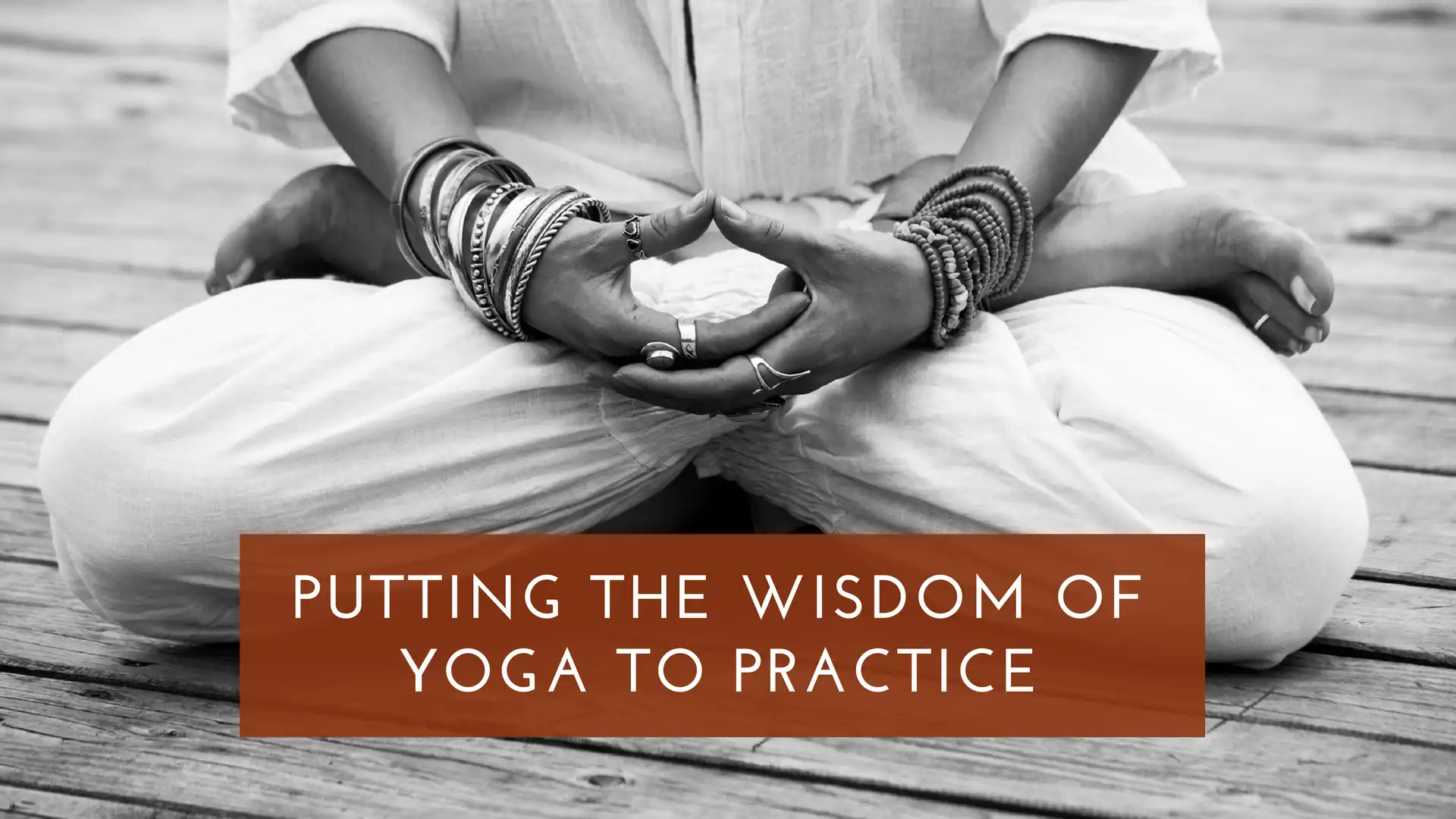Change Your Mind: Putting the Wisdom of Yoga into Practice

What a difference there is between reading a bunch of wise words in an ancient yoga text—or any book for that matter—and actually living wisely! Many years ago, when I was suffering from stress-related anxiety, a new therapist said to me, “Stop worrying so much.” It’s almost funny now, but at the time, I was horrified (and never went back to see that therapist). Well, yes, I needed to stop worrying so much, but just being instructed to stop worrying wasn’t exactly helpful, as you might imagine.
So, how do we move from being inspired by words of wisdom to incorporating wisdom into our daily lives? In the Bhagavad Gita, Arjuna asks Krishna this very question:
“You have taught the essence of yoga
is equanimity, Krishna;
but since the mind is so restless,
how can that be achieved?
The mind is restless, unsteady,
turbulent, wild, stubborn;
truly, it seems to me
as hard to master as the wind.”
—translated by Stephen Mitchell
Krishna replies that, yes, the mind is hard to master, but the answer to mastering it is “constant practice.”
“You are right, Arjuna: the mind
is restless and hard to master;
but by constant practice and detachment
it can be mastered in the end.”
—translated by Stephen Mitchell
Yes, everything we want to do well takes practice, and that includes achieving the goals we set for our yoga practice. Whether these goals are cultivating equanimity, changing the way we react to stress, meditating to quiet our minds, or even just improving balance or strength, practicing is the only path that will take us there. The Yoga Sutras expand on this concept of practice by saying that practice should be diligent, combined with unattached awareness (detachment), and pursued with “eagerness, sincerity, and continuity” for a long time.
Although these recommendations were specifically for quieting the mind (the goal of yoga in the Yoga Sutras), they apply whatever your goal is. So keep that in mind every time you take your first steps on a new path for cultivating well-being, whether physical, emotional, or spiritual.
Of course, it’s easy enough to imagine diligently practicing strengthening poses to foster physical strength, stress management practices to reduce chronic stress, or equanimity practices to balance your emotions. But how do you diligently practice wisdom?
Unfortunately, we all have habitual, ingrained patterns of thought and ways of reacting to challenges that are hard to change. You might say we’re stuck in some serious ruts! As a matter of fact, the yogis have a term for these ingrained patterns of thought and behavior patterns: samskaras (subliminal activators). They say that with every thought we have and action we take we leave impressions on “the hot wax of the mind,” and these impressions get deeper and deeper with repetition. And in his book Yoga and the Quest for the True Self, psychologist Stephen Cope actually describes samskaras as “ruts:”
“Samskaras are like little tracks, little vectors, little ruts in the muddy road. The next time the car travels that road, these muddy ruts will have hardened into permanent fixtures, and the car wheels will want to slide into them. Indeed it’s easier to steer right into them than to try to avoid them.”
So it takes diligent practice combined with detachment to avoid these ruts and change your mental habits! The first step is to observe your mental habits, with unattached awareness. As you meditate, practice yoga mindfully, and go about your everyday life, notice, without judgment, the habitual way your mind works. For example, as I worked with my tendency toward anxiety, I observed a pattern of worrying about the future, even about events that might not even happen. For fun, I called my rut “panicking too soon.”
The second step is to use the wisdom of yoga to respond with a more helpful reaction or thought. The Yoga Sutras recommend practicing pratipaksha bhavanam, which means “cultivate the opposite” or “cultivate counteracting thoughts:”
II.33 “Upon being harassed by negative thoughts, one should cultivate counteracting thoughts.”—translated by Edwin Bryant
This could mean consciously thinking with compassion for someone you dislike or for yourself when you feel self-hatred. It could mean cultivating gratitude for good things in your life when you’re feeling unhappy with your current circumstances. For me, this meant that every time I would catch myself spiraling into anxiety, I would remind myself there was another way to respond to stressful situations by reciting this stanza from the Bhagavad Gita:
“Self-possessed, resolute, act
without any thought of results,
open to success or failure.
This equanimity is yoga.”
—translated by Stephen Mitchell
A colleague and yoga teacher, Beth Gibbs, recommends writing down your counteracting thought and taping it to the fridge or bathroom mirror so it’s visible every day, and repeating it often, silently or out loud, as you move through your yoga practice or even through your day, so it’s mentally handy when you notice yourself slipping back into your old ruts. She says that over time and with practice this technique enables you to transform an unhealthy reaction into a positive, productive response.
As I continued practicing this technique, I eventually noticed that the more often I responded to stress by reminding myself that I could let go of thoughts of results, the easier it became. I felt that cultivating this new habit was like using an initially weak muscle that got stronger and stronger with each repetition. Another way to think of it is that you’re creating a new, positive samskara to replace the old one. In this way, Edwin Bryant compares negative thoughts to weeds and positive thoughts to flowers.
“As in a garden, the more one makes an effort to uproot weeds, the more the bed will eventually become a receptacle for fragrant flowers, which will then grow and reseed of their own accord until there is hardly any room for the weeds to surface.”
Another contributor post to inspire your practice from YogaUOnline and Kristin Olson – Slow Yoga: How to Deepen Your Practice.
Reprinted with permission from Yoga for Healthy Aging.
 Nina Zolotow, RYT 500, Editor-in-Chief of the Yoga for Healthy Aging blog, is both a yoga writer and a yoga teacher. She trained to be a yoga teacher at The Yoga Room in Berkeley, California, has studied yoga therapy with Shari Ser and Bonnie Maeda, and is especially influenced by the teachings of Donald Moyer. She also studied extensively with Rodney Yee, and is inspired by the teachings of Patricia Walden on yoga for emotional healing. Her special area of expertise is yoga for emotional well-being (including yoga for stress, insomnia, depression, and anxiety) and she teaches workshops and series classes on yoga for emotional well-being, stress management, better sleep, home practice, and cultivating equanimity. Nina is the co-author with Baxter Bell of Yoga for Healthy Aging: A Guide to Lifelong Well-Being and co-author with Rodney Yee of Yoga: The Poetry of the Body (with its companion 50 Card Practice Deck) and Moving Toward Balance. She is also the author of numerous articles on yoga and alternative medicine.
Nina Zolotow, RYT 500, Editor-in-Chief of the Yoga for Healthy Aging blog, is both a yoga writer and a yoga teacher. She trained to be a yoga teacher at The Yoga Room in Berkeley, California, has studied yoga therapy with Shari Ser and Bonnie Maeda, and is especially influenced by the teachings of Donald Moyer. She also studied extensively with Rodney Yee, and is inspired by the teachings of Patricia Walden on yoga for emotional healing. Her special area of expertise is yoga for emotional well-being (including yoga for stress, insomnia, depression, and anxiety) and she teaches workshops and series classes on yoga for emotional well-being, stress management, better sleep, home practice, and cultivating equanimity. Nina is the co-author with Baxter Bell of Yoga for Healthy Aging: A Guide to Lifelong Well-Being and co-author with Rodney Yee of Yoga: The Poetry of the Body (with its companion 50 Card Practice Deck) and Moving Toward Balance. She is also the author of numerous articles on yoga and alternative medicine.


